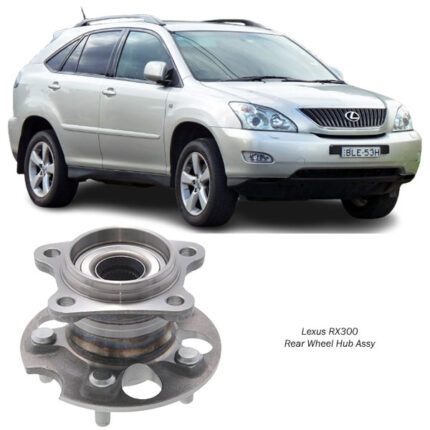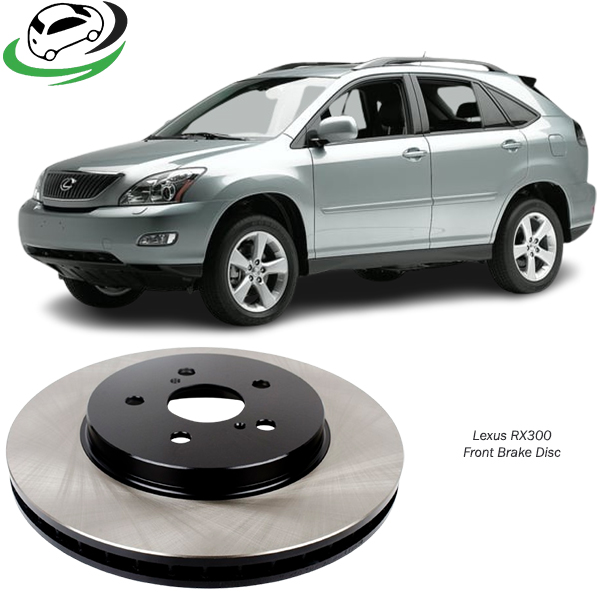-13%
Get Lexus RX300 Front Brake Disc 43512-48081 in Kenya
The front brake disc, commonly referred to as a rotor, is a fundamental component in the braking system of vehicles, working alongside brake pads and calipers to safely slow down or halt a car. Due to the crucial role it plays in the braking system, understanding the functionality, advantages, and maintenance of the front brake disc is essential. Here, we’ll delve into its construction, operation, types, and maintenance, as well as signs of wear and tear, to ensure it remains effective and safe for long-term use.
1. Overview and Structure of the Front Brake Disc
The front brake disc is a circular, flat, metallic component located behind the wheel, directly attached to the wheel hub. It rotates in sync with the wheel and is part of a disc brake assembly, which consists of a caliper and brake pads that press against the disc surface to create friction. This friction generates resistance, slowing down or stopping the wheel’s rotation.
Most brake discs are made from cast iron, known for its durability and heat resistance. However, certain high-performance or premium vehicles use discs made of ceramic, carbon-composite, or carbon-ceramic materials for better heat dissipation, strength, and longevity. The surface of the disc is often grooved or drilled to dissipate heat and allow gases and dust to escape, especially in performance applications. Vented discs are also common for front brakes, as they have an internal chamber to help release heat, which is crucial for the heavy braking demands typically placed on the front wheels.
2. Functionality of the Front Brake Disc
The primary function of the front brake disc is to slow down and stop the vehicle by converting kinetic energy into heat energy. Here’s a breakdown of how it works:
- Brake Application: When the driver presses the brake pedal, the brake fluid is pressurized and flows to the brake caliper.
- Caliper Action: This pressure forces the brake caliper to clamp the brake pads against the rotating disc.
- Friction and Heat Generation: The friction between the brake pads and the disc’s surface causes the rotation to slow down, gradually bringing the vehicle to a halt.
- Heat Dissipation: The brake disc’s design facilitates heat dissipation. Grooves or holes in the disc, and even the material itself, ensure that the disc cools quickly, maintaining braking efficiency over extended or high-speed driving.
Since most of a vehicle’s stopping power is generated by the front brakes, front brake discs are particularly critical. They not only provide effective braking power but also maintain stability during rapid deceleration.
3. Types of Front Brake Discs
Front brake discs come in various types, each suited for different driving conditions and vehicle requirements. Here are some of the most common types:
- Solid Discs: Basic and cost-effective, solid discs are found on smaller or less powerful vehicles. They’re more affordable but may not dissipate heat as effectively as vented options.
- Vented Discs: With an air gap between two disc surfaces, vented discs are designed to release heat more efficiently. These are commonly used in most modern vehicles and are ideal for preventing brake fade.
- Drilled Discs: Drilled discs have holes that help release heat and gases generated during braking. While they offer improved performance, they can be prone to cracking over time.
- Slotted Discs: Slotted or grooved discs have channels that help clear away debris and dissipate heat, enhancing braking performance. These are frequently used in high-performance vehicles.
- Carbon-Ceramic Discs: Found on high-performance and luxury vehicles, carbon-ceramic discs offer excellent heat tolerance and durability. Although costly, they are lightweight and resistant to extreme heat.
Choosing the appropriate type of front brake disc largely depends on the vehicle’s intended use. For instance, drilled and slotted discs might suit performance vehicles better, while vented discs are generally ideal for everyday driving.
4. Benefits of Front Brake Discs
The use of front brake discs in the braking system offers several key advantages:
- Efficient Heat Dissipation: Front brake discs are designed to handle and dissipate heat effectively, reducing the chances of brake fade and ensuring consistent performance during extended use.
- Enhanced Stopping Power: Disc brakes generally offer superior stopping power, providing more stability and control during sudden braking, especially at higher speeds.
- Less Susceptibility to Moisture: Unlike drum brakes, disc brakes are less affected by water, which ensures better performance in wet conditions.
- Reduced Maintenance Costs: Many disc brakes are designed for quick replacement of brake pads, reducing maintenance time and costs compared to other braking systems.
- Improved Durability and Longevity: Front brake discs, especially when made from high-quality materials, are more durable under extreme braking conditions and last longer when properly maintained.
5. Maintenance of Front Brake Discs
Regular maintenance is crucial to ensure the longevity and performance of front brake discs. Some recommended maintenance practices include:
- Routine Inspection: Checking the brake discs and pads regularly helps spot issues like uneven wear, cracks, or scoring on the disc surface. This inspection can usually be done during routine servicing.
- Brake Pad Replacement: Since brake pads wear faster than discs, replacing pads at regular intervals is essential. This practice also prevents excessive wear on the disc surface.
- Cleaning: Brake dust and other contaminants can accumulate on the disc surface, reducing braking performance. Cleaning the discs with a mild brake cleaner can help maintain their functionality.
- Proper Bedding-In: When new brake discs and pads are installed, proper bedding-in ensures optimal contact and performance. This involves gradually applying the brakes during the initial drives to create an even layer of material from the pads onto the disc.
- Avoiding Overheating: Excessive or aggressive braking, especially when descending steep slopes, can overheat the brake discs. Drivers can use engine braking or take breaks on long descents to allow the brakes to cool.
6. Signs of Wear and When to Replace Front Brake Discs
Despite regular maintenance, brake discs will eventually wear out. Here are some common signs that indicate it may be time to replace the front brake discs:
- Reduced Braking Performance: If the vehicle takes longer to stop or if there’s a noticeable decrease in braking power, it may be due to worn brake discs.
- Vibrations: A vibrating or pulsating brake pedal, especially during braking, can indicate a warped or uneven disc surface.
- Visible Cracks or Scoring: Deep grooves, cracks, or scoring on the disc surface are clear indicators that replacement is necessary. Cracked discs are especially dangerous and should be replaced immediately.
- Squealing or Grinding Noise: Unusual noises, such as squealing or grinding when braking, often indicate worn-out brake pads, which may have damaged the disc.
- Disc Thickness: If the brake disc becomes thinner than the manufacturer’s specified minimum thickness due to wear, it should be replaced. Mechanics use calipers to measure disc thickness during servicing.
7. Safety and the Importance of Front Brake Discs
The front brake disc is critical for vehicle safety, playing an essential role in preventing accidents and ensuring the car can stop reliably when needed. Regular maintenance, timely replacement of worn brake components, and using quality parts are vital for maintaining safety on the road. High-quality brake discs are specifically designed to perform well under various driving conditions and are less likely to warp or crack under high-stress situations.
8. Conclusion
The front brake disc is a sophisticated component, engineered to provide effective stopping power, stability, and reliability. By understanding its functions, types, and maintenance needs, vehicle owners can ensure their braking system remains safe and effective. Regular inspections, timely replacements, and cautious driving can extend the lifespan of brake discs, allowing them to operate efficiently under various conditions.
Follow us on Facebook for more parts.



